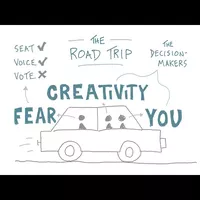(1810) 5 Big Ideas from Big Magic by Elizabeth Gilbert - YouTube
Hello and welcome to Verbal to Visual. Today I would like to do some iPad
sketchnoting as I share with you five big ideas from the book Big Magic by
Elizabeth Gilbert. In this book gilbert shares her thoughts on what it looks
like to live a creative life. There's this analogy that she shares - the road
trip - that's really helpful in dealing with the fears that inevitably crop up
when doing vulnerable creative work. On this road trip are three passengers: you,
your creativity, and your fear. Acknowledging that fear will always be
there is helpful. As Gilbert says, "I don't try to kill off my fear. I don't go to
war against it. Instead, I make all that space for it."
Here's the key, though: you make space for it, but you also put it in its place.
"Creativity and I are the only ones who will be making any decisions along the
way. You're allowed to have a seat, and you're
allowed to have a voice, but you are not allowed to have a vote." I really
appreciate how this approach acknowledges fears existence, while
stripping away its power over you. Another idea from Big Magic that I found
to be useful has to do with a paradox that folks living a creative life need
to come to terms with. That paradox goes like this. There are two approaches that
you must take when doing and sharing creative work. Your creative expression
must be the most important thing in the world to you, if you are to live
artistically. And it must not matter at all, if you are to live sanely. And at
times you'll have to leap back and forth between these two perspectives in a
matter of minutes. For me at least, it's the second perspective, the one on the
right, that I need to remind myself of. And in many cases it has to do with the
reaction that other folks have to your creative work. As Gilbert points out, that
reaction doesn't belong to you, so you can't put your overall well-being in the
hands of strangers whose reaction to your work says more about them than it
does about you. In the section of this book that talks about persistence,
there's another analogy that I found to be helpful. This one comes from poet
Seamus Heaney and starts with the idea that a person should not
expect to be immediately good at the thing they're working on. Quoting Gilbert,
"The aspiring poet is constantly lowering a bucket only halfway down a well, coming
up time and again with nothing but empty air. The frustration is immense, but you
must keep doing it anyway. After many years of practice, Heaney explained, 'The
chain draws unexpectedly tight and you have dipped into waters that will
continue to entice you back. You'll have broken the skin on the pool of yourself.'"
This echoes nicely Gilbert's definition of a creative life, which she shared
earlier in the book, acknowledging that we all have jewels deep within ourselves
and to live a creative life means to be on the hunt for those jewels. And it's
the hunt, it's the effort, that makes your life
creative, not any particular results. In the same section on persistence, Gilbert
addresses the inevitable frustrations that come along with your creative work,
and how hard it can be to go from having great ideas one day to no ideas the next.
But as Gilbert says, "Frustration is not an interruption of your process.
Frustration is the process." And, just as important, "How you manage yourself
between those bright moments is a measure of how devoted you are to your
vocation." Here I appreciate the wholistic nature of Gilbert's approach to living a
creative life, that a large part of it is sustaining your body and your mind,
giving it what it needs so that it can show up to the creative work in a full
way. The last idea that I would like to share here, similar to the paradox that I
mentioned a few minutes ago, has to do with the perspective from which you view
your creative efforts and the results of those efforts. To quote Gilbert, "Sometimes
I think that the difference between a tormented creative life and a tranquil
creative life is nothing more than the difference between the word awful and
the word interesting. Interesting outcomes, after all, are just awful
outcomes with the volume of drama turned way down." It's sometimes amazing how
slight little shifts in mindset, like this one here, can have
dramatic effects on the quality of your life, once you learn to apply them
consistently. And that might be what all five of these ideas have in common.
They're about the mindset that you establish as you go about doing your
work living a creative life. I hope that you have enjoyed seeing these ideas
shared in this visual way. I do encourage you to pick up the book Big Magic
because this here is a mere sprinkling of the good ideas that you'll find
throughout it. And if you'd like to add the skill of visual note-taking to your
creative toolkit, to be able to sketch out the ideas that you're learning in a
similar way to what you've seen here, then check out the resources at
www.verbaltovisual.com. You might start with my course An Introduction to Visual
Note-Taking, and then go from there. You can find links to that resource and
others down below this video. Thanks for watching and I'll see you again next
time.

